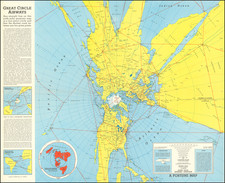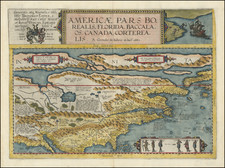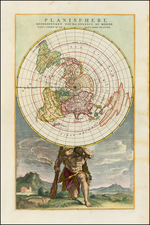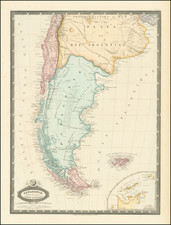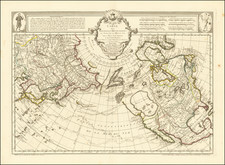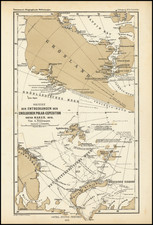Exploring Antarctica by Sea and Air—with Manuscript Additions by an Officer on the Second Byrd Antarctic Expedition!
Striking map of King Edward VII Land, drawn from aerial photographs taken on the first Antarctic expedition of Richard Byrd, published by the American Geographical Society for their Geographical Review.
What makes this example of the map special are the extensive manuscript additions that were likely added by Lieutenant Robert A. J. English, commander of the Bear of Oakland on the second Byrd expedition in 1934. An inscription in the lower right corner reads: "Lieut. R.G.J. English, US Navy, Commanding, ‘Bear of Oakland’ Byrd Antarctic Expedition II.” From a comparison of signature samples, we can confirm this inscription was written by English.
The pencil annotations include the course of The Bear of Oakland on February 7th and 8th, 1935. The course corresponds to the description of the ship's arduous voyage through the ice to the northeast of the Bay of Whales, as described on pages 107-109 in Byrd's book Discovery.
The annotations also show the locations of various camps and their commanding officers, such as that of Senior Meteorologist William Haines, as well as corrections to the mapping of certain geographical features in Antarctica, such as the positions of The Rockefeller Mountains and parts of the continent's coastline.
Based on these detailed additions, it is quite possible that this map was on The Bear of Oakland during the voyage, used as a working map for English to record his course, his colleagues’ locations, and the inconsistencies that he was able to record between previously published maps of the region and what he observed while on site.
This map is a unique survival.
The First and Second Byrd Expeditions to Antarctica
The United States first probed Antarctica in the famed U.S. Exploring Expedition (1838-1842) led by Charles Wilkes. The next American expedition would not return until 1928 under the command of naval pilot Richard E. Byrd.
Byrd had joined the United States Naval Academy at twenty, gaining his commission in 1912. He learned to fly in World War I, which led to his work as a flight instructor for the US Navy. His influence led the navy to plan the flight path for a transatlantic flight of several of its planes; one of these, NC4, made it across in May 1919 via Newfoundland and the Azores. Byrd continued to be interested in extreme and long-haul flights. In 1926, he and co-pilot Floyd Bennett were the first to fly over the North Pole. After that icy achievement, Byrd turned his sites on Antarctica.
Byrd’s fame made him a natural choice for leading the Antarctic expedition organized in 1928. He and his men traveled in the City of New York, the Eleanor Bolling, the Sir James Clark Ross, and the C. A. Larsen. The mission combined the latest in mechanical technology, including airplanes, aerial cameras, snowmobiles, and communications infrastructure. Byrd was on the second airplane flight in Antarctica, piloted by Bernt Balchen on January 15, 1929. The first flight, by Sir Hubert Wilkins, occurred just ten weeks earlier. While there, Byrd’s men flew three separate types of planes (Ford monoplane, Fokker Universal, and Fairchild monoplane) at high latitudes, taking photographs as they went. On one of these flights, Byrd sighted and named the Rockefeller Mountains. Later, his men sighted and named the Grosvenor Mountains, the Edsel Ford Range, and Marie Byrd Land. Finally, on November 29, 1929, Byrd flew over the South Pole. These flights were tied to ground surveys, producing new maps, including this one. His crews set up the most elaborate communications system to date, establishing contact with the outside world and each other. The flights and comms teams operated out of Little America, the new base that Byrd founded.
The expedition returned triumphantly in 1930, but questions remained. Byrd spearheaded the planning of a follow-up mission which departed in 1933. This expedition was the first to effectively use automobiles in Antarctica, the first to conduct seismic investigations (to understand the extent of the Ross Ice Shelf), and the first to broadcast radio programs, which kept the public riveted for the duration of the voyage. Byrd arrived with four additional aircraft, while the crews also had a tractor, two snowmobiles, three Citroëns, and 153 dogs at their disposal. Byrd’s men relied for transport on the Jacob Ruppert and the Bear of Oakland; the latter was commanded Robert A. J. English. The Bear of Oakland was a 200-foot sailing ship with auxiliary steam power.
The Bear of Oakland left Boston on September 25, 1933. It quickly ran into a hurricane off of North Carolina and had to enter dry dock in Newport News for repairs. The ship set sail again on November 1, passing through the Panama Canal on November 17. English and the ship stopped for coal in Tahiti and then set off for Wellington, arriving on January 6. The ship then sailed for Antarctica on January 19, arriving on the night of January 30, 1934. The Jacob Ruppert had already arrived, and both ships were quickly unloaded. The Bear of Oakland acted as the site for the radio station, KFZ, that transmitted Byrd’s updates, “The Adventures of Admiral Byrd” to eager listeners.
The Jacob Ruppert returned to New Zealand, but English and the Bear of Oakland had another task. The ship was supposed to sail out of the Bay of Whales toward Cape Colbeck. English and his men were to see if they could locate an archipelago that was rumored to be nearby. They sailed as far east as 75°06’ E, only the third ship to make it east of Cape Colbeck. They sighted the Ford Ranges to the southeast and detected a submarine mountain range northwest of the Edward VII Peninsula. This is the area and the ship’s track shown on this map.
The Bear of Oakland returned to the Bay of Whales and left for New Zealand in early March 1934. Byrd and some of his men stayed for the winter at outposts near Advance Base, taking meteorological and biological observations and broadcasting radio programs. Byrd suffered from carbon monoxide poisoning and was sick for a month. During the field season, some of the crew summited McKinley Peak, calculating that it was 37 miles farther west than previously thought.
The Bear of Oakland returned in January 1935. The men loaded the ships, with the Bear ferrying cargo to the thin-plated Jacob Ruppert. They left on February 5 with most of their supplies (they left behind a tractor and two snowmobiles). The Jacob Ruppert also carried the Floyd Bennett, the plane with which Byrd had flown over the South Pole on the first expedition. The ships also carried with them several penguins which found new homes in American zoos. They returned to the United States via New Zealand to great fanfare.
These first expeditions had been financed by Byrd. For his remaining Antarctic expeditions, the US Navy stepped in. Byrd planned three more trips: Byrd’s third expedition (1939-41), Operation High Jump (1946-7), and Operation Deep Freeze (1955-6).
Robert English’s later career
Robert English went on to a distinguished naval career and was decorated for his service in World War II. He retired as a Rear Admiral. For his work on the Bear of Oakland, English was awarded the Navy Distinguished Service Medal. His commendation reads:
The President of the United States of America takes pleasure in presenting the Navy Distinguished Service Medal to Lieutenant Robert Allen Joseph English (NSN: 0-57546), United States Navy, for exceptionally meritorious and distinguished service in a position of great responsibility to the Government of the United States as Commanding Officer of the Byrd Antarctic Expedition II ship, SS BEAR OF OAKLND, which during the time it was in Antarctic Waters did some very important and hazardous work in exploration to the northeastward of Little America. Through his courage, resourcefulness and engineering ability, Lieutenant English on several occasions saved the BEAR OF OAKLAND from disaster. All of his service with the expedition was performed with exceptional efficiency contributing greatly to its success.
Today, his papers are housed at the Archives Branch of Naval History and Heritage Command in Washington D. C.









